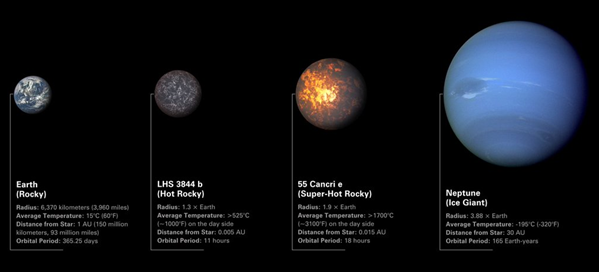

Context
The James Webb Space Telescope will observe two giant Earth-like planets as part of its initial observations: 55 Cancri e and LHS 3844 b.
About
- Among the investigations that are planned for the telescope’s first year are two exoplanets classified as “super-Earths”: the lava covered 55 Cancri e and the atmosphere-less LHS 3844 b.
- They are classified as super-Earths due to their size and rocky composition.
- 55 Cancri e: Super-hot super-Earth
- 55 Cancri e is an exoplanet that orbits less than 1.5 million miles from its star, which is 4 per cent of the distance between Mercury and the sun.
- This means that the planet completes an entire revolution around its star in less than 18 hours.
- Basically, a year on 55 Cancri e is equivalent to 18 Earth hours.
- LHS 3844 b: Literally cooler
- Unlike 55 Cancri e, LHS 3844 b will offer a unique opportunity to analyse solid rock on an exoplanet surface.
- LHS 3844 b orbits extremely close to its star; completing a full orbit in 11 hours.
- But since its star is relatively small and cool, the exoplanet’s surface is not hot enough for the surface to be molten.

About James Webb Space Telescope:
- The James Webb Space Telescope is the largest, most powerful space telescope ever built. It will allow scientists to look at what our universe was like about 200 million years after the Big Bang.
- The telescope will be able to capture images of some of the first galaxies ever formed.
- It will also be able to observe objects in our solar system from Mars outward, look inside dust clouds to see where new stars and planets are forming and examine the atmospheres of planets orbiting other stars.
- The James Webb Space Telescope will use its infrared cameras to see through dust in our universe.
- Stars and planets form inside those dust clouds, so peeking inside could lead to exciting new discoveries.
- It will also be able to see objects (like the first galaxies) that are so far away that the expansion of the universe has made their light shift from visible to infrared.
- Webb has a sunshield to protect its instruments and mirrors as the Webb telescope’s cameras are sensitive to heat from the Sun.
- Webb telescope has 18 smaller mirrors that fit together like a puzzle. The mirrors fold up inside the rocket, then unfold to form one large mirror in orbit.
- The James Webb Space Telescope will help to study the atmospheres of exoplanets.



